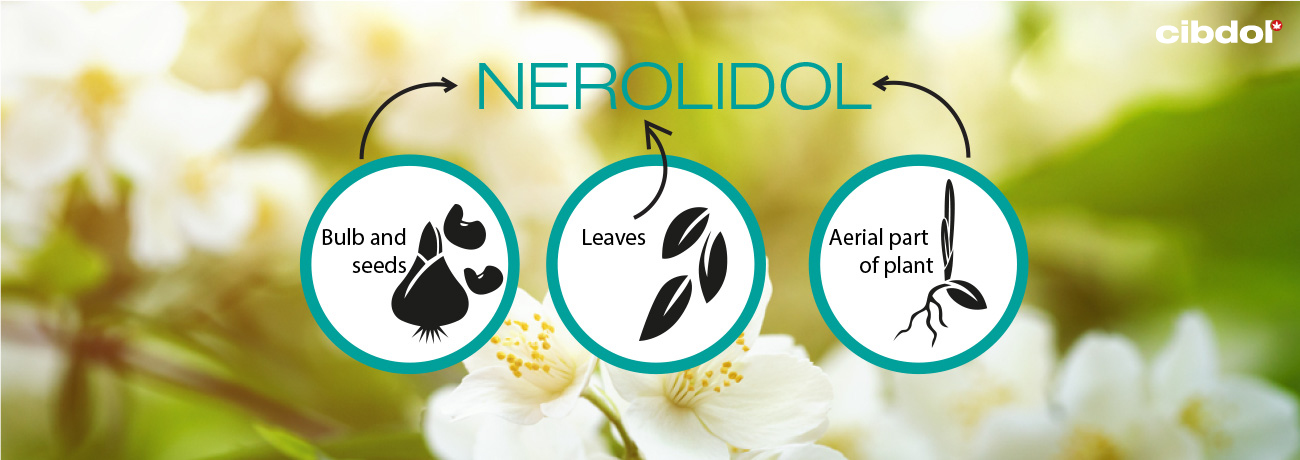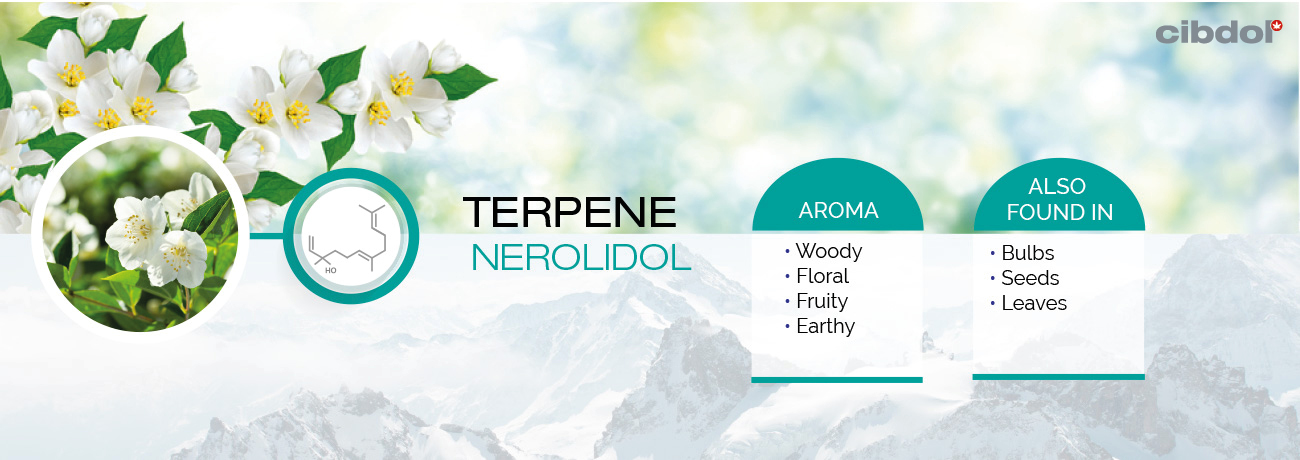What is Nerolidol?

As one of over 40,000 terpenes occurring in nature, nerolidol features in many plant species that produce floral odours. The molecule also appears in various herbs used in folk medicine systems. Interestingly, modern research is probing this terpene in an effort to elucidate its therapeutic prowess. Results from early experiments have produced some promising results.
The trichomes of cannabis flowers also produce the terpene, which lends to the taste and aroma of some strains. However, researchers only found the molecule in small quantities when analysing Californian cultivars. Nerolidol belongs to the sesquiterpene chemical family, a group of compounds that are less volatile and more pungent than other terpenes.
Many companies have harnessed nerolidol’s strong and pleasant smell in countless cosmetic and cleaning products. Reports[1] suggest that, each year, these industries use 10–100 metric tonnes of the terpene. Nerolidol’s fresh odour occurs in everything from shampoos and perfumes to detergents and cleansers. The US Food and Drug Administration has also classed nerolidol as a safe food flavouring; you can find it infused into many food products as a flavour enhancer.
Aroma
Nerolidol contributes to the woody, floral, fruity, and earthy aromas of many plants, fruits, and culinary herbs. Overall, the combination of these notes creates a smell not dissimilar to fresh tree bark.
Also found in
Many plants produce nerolidol as a secondary metabolite. It occurs in the bulbs, seeds, leaves, and aerial parts of many species. The terpene plays a protective role against predatory herbivores that would otherwise devour plants.
Nerolidol is a constituent of ginger, jasmine, tea tree, lavender, lemongrass, eucalyptus, sweet basil, green and black tea, cardamom, stevia, tarragon, lemon verbena, thyme, and star anise.

Possible effects
Research conducted in cell and animal models suggests nerolidol to display myriad therapeutic effects. These include:
• Anti-inflammatory
• Antinociceptive
• Antitumour
• Antioxidant
• Neuroprotective
• Antiulcer
Neriodiol appears to synergise with certain cannabinoids, enhancing their medicinal properties—a phenomenon known as the entourage effect. So far, research has found the terpene to bolster the sedating potential of CBN[2].
Supporting research
All of the promising research regarding nerolidol is preclinical. Thorough clinical trials are required to confirm how the terpene affects humans. However, this early research offers an interesting insight into possible future therapeutic applications.
• Anti-inflammatory and antinociceptive
Nerolidol might be able to help reduce inflammation—a physiological state implicated in many states of disease[3]. Research[4] published in the journal Clinical Pharmacology investigated the antinociceptive and anti-inflammatory properties of nerolidol in mouse models of pain.
After subjecting the mice to a battery of tests designed to induce pain, the researchers found varying doses of nerolidol to be effective at reducing pain. They raise the possibility that the terpene might achieve these effects through the GABAergic system—a network involved in the creation and metabolism of the neurotransmitter GABA.
GABA neurons are associated with regulating the control of sensory information in the spine, and the neurotransmitter plays a role in the mediation and perception of pain. The researchers also found nerolidol to reduce the production of inflammatory molecules—including interleukins—in a mouse model of inflammation.
• Antitumour
Numerous animal studies suggest that nerolidol might help to reduce tumour size and occurrence. One study[5], published in the journal Carcinogenesis, tested these effects on mice exposed to a potent carcinogen that promotes tumour growth in the colon.
Researchers observed that mice fed nerolidol showed a reduction in intestinal tumours. The numbers plummeted from 82 to 33%. The authors of the paper state that “The effects of nerolidol are of interest in terms of the identification of a new inhibitor of carcinogenesis of the large bowel”.
Another study[6] explored the antitumour effects of the essential oil of Zornia brasiliensis, a plant high in nerolidol and other terpenes. Researchers administered the oil to mice and found it to reduce tumour growth by rates of 1.68–38.61%.
• Antioxidant and neuroprotective
As an antioxidant, nerolidol might be able to defend against oxidative stress and subsequent DNA damage. Several cell studies demonstrate the potent antioxidant activity of nerolidol, as well as the terpene’s ability to counter the effects of free radicals. The molecule appears to be capable of protecting lipids, proteins, and DNA from oxidative damage.
An animal study[7] suggests that these antioxidant effects might produce neuroprotective properties. The researchers observed the effects of nerolidol against oxidation in the hippocampus of mice. The terpene catalysed a protective effect by boosting the production of antioxidant enzymes, scavenging free radicals, and preventing lipid peroxidation.
• Antiulcer
Nerolidol might play a role in the future treatment of gastric ulcers. The condition affects millions of people annually and has multiple causes. Certain strains of bacteria and non-steroidal anti-inflammatory drugs (NSAIDs) often trigger them. However, factors such as smoking and stress contribute to their development.
A 2014 study[8] tested the effects of nerolidol on different experimental ulcer models in mice. The researchers found the terpene to produce a significant reduction in stress-induced ulcers. The terpene also inhibited ethanol-induced ulcers by 52.63% when delivered in a dose of 250mg/kg, and by 87.63% at a dose of 500mg/kg. Nerolidol also significantly inhibited ulcers caused by the NSAID indomethacin.
The researchers concluded that their findings suggest nerolidol could be used in gastroprotective and antiulcer treatments.
[1] Chan, W. K., Tan, L., Chan, K. G., Lee, L. H., & Goh, B. H. (2016). Nerolidol: A Sesquiterpene Alcohol with Multi-Faceted Pharmacological and Biological Activities. Molecules, 21(5), 529. https://doi.org/10.3390/molecules21050529 [Source]
[2] Russo, E. B. (2011). Taming THC: potential cannabis synergy and phytocannabinoid-terpenoid entourage effects. British Journal of Pharmacology, 163(7), 1344–1364. https://doi.org/10.1111/j.1476-5381.2011.01238.x [Source]
[3] Harvard Health Publishing. (2020). Understanding acute and chronic inflammation. https://www.health.harvard.edu/staying-healthy/understanding-acute-and-chronic-inflammation [Source]
[4] Fonsêca, D. V., Salgado, P. R. R., de Carvalho, F. L., Salvadori, M. G. S. S., Penha, A. R. S., Leite, F. C., Borges, C. J. S., Piuvezam, M. R., Pordeus, L. C. D. M., Sousa, D. P., & Almeida, R. N. (2015). Nerolidol exhibits antinociceptive and anti-inflammatory activity: involvement of the GABAergic system and proinflammatory cytokines. Fundamental & Clinical Pharmacology, 30(1), 14–22. https://doi.org/10.1111/fcp.12166 [Source]
[5] Wattenberg, L. W. (1991). Inhibition of azoxymethane-induced neoplasia of the large bowel by 3-hydroxy-3,7,11-trimethyl-l,6,10-dodecatriene (nerolidol). Carcinogenesis, 12(1), 151–152. https://doi.org/10.1093/carcin/12.1.151 [Source]
[6] Costa, E., Menezes, L., Rocha, S., Baliza, I., Dias, R., Rocha, C., Soares, M., & Bezerra, D. (2015). Antitumor Properties of the Leaf Essential Oil of Zornia brasiliensis. Planta Medica, 81(07), 563–567. https://doi.org/10.1055/s-0035-1545842 [Source]
[7] Nogueira Neto, J. D., Cardoso De Almeida, A. A., & da Silva Oliveira, J. (2013). Antioxidant Effects of Nerolidol in Mice Hippocampus After Open Field Test. Springer Link. https://link.springer.com/article/10.1007/s11064-013-1092-2 [Source]
[8] Klopell, F. C., Lemos, M., Sousa, J. P. B., Comunello, E., Maistro, E. L., Bastos, J. K., & Andrade, S. F. D. (2007). Nerolidol, an Antiulcer Constituent from the Essential Oil of Baccharis dracunculifolia DC (Asteraceae). Zeitschrift Für Naturforschung C, 62(7–8), 537–542. https://doi.org/10.1515/znc-2007-7-812 [Source]
[1] Chan, W. K., Tan, L., Chan, K. G., Lee, L. H., & Goh, B. H. (2016). Nerolidol: A Sesquiterpene Alcohol with Multi-Faceted Pharmacological and Biological Activities. Molecules, 21(5), 529. https://doi.org/10.3390/molecules21050529 [Source]
[2] Russo, E. B. (2011). Taming THC: potential cannabis synergy and phytocannabinoid-terpenoid entourage effects. British Journal of Pharmacology, 163(7), 1344–1364. https://doi.org/10.1111/j.1476-5381.2011.01238.x [Source]
[3] Harvard Health Publishing. (2020). Understanding acute and chronic inflammation. https://www.health.harvard.edu/staying-healthy/understanding-acute-and-chronic-inflammation [Source]
[4] Fonsêca, D. V., Salgado, P. R. R., de Carvalho, F. L., Salvadori, M. G. S. S., Penha, A. R. S., Leite, F. C., Borges, C. J. S., Piuvezam, M. R., Pordeus, L. C. D. M., Sousa, D. P., & Almeida, R. N. (2015). Nerolidol exhibits antinociceptive and anti-inflammatory activity: involvement of the GABAergic system and proinflammatory cytokines. Fundamental & Clinical Pharmacology, 30(1), 14–22. https://doi.org/10.1111/fcp.12166 [Source]
[5] Wattenberg, L. W. (1991). Inhibition of azoxymethane-induced neoplasia of the large bowel by 3-hydroxy-3,7,11-trimethyl-l,6,10-dodecatriene (nerolidol). Carcinogenesis, 12(1), 151–152. https://doi.org/10.1093/carcin/12.1.151 [Source]
[6] Costa, E., Menezes, L., Rocha, S., Baliza, I., Dias, R., Rocha, C., Soares, M., & Bezerra, D. (2015). Antitumor Properties of the Leaf Essential Oil of Zornia brasiliensis. Planta Medica, 81(07), 563–567. https://doi.org/10.1055/s-0035-1545842 [Source]
[7] Nogueira Neto, J. D., Cardoso De Almeida, A. A., & da Silva Oliveira, J. (2013). Antioxidant Effects of Nerolidol in Mice Hippocampus After Open Field Test. Springer Link. https://link.springer.com/article/10.1007/s11064-013-1092-2 [Source]
[8] Klopell, F. C., Lemos, M., Sousa, J. P. B., Comunello, E., Maistro, E. L., Bastos, J. K., & Andrade, S. F. D. (2007). Nerolidol, an Antiulcer Constituent from the Essential Oil of Baccharis dracunculifolia DC (Asteraceae). Zeitschrift Für Naturforschung C, 62(7–8), 537–542. https://doi.org/10.1515/znc-2007-7-812 [Source]







